#UX/UI Design career path
Explore tagged Tumblr posts
Text
UI/UX Design Career Path in 2025: Everything You Need to Know
Introduction
The field of UI/UX design has evolved rapidly over the past decade, making it one of the most sought-after careers in the tech industry. As we step into 2025, the demand for skilled UI/UX designers continues to rise, with businesses emphasizing user-centered design more than ever. This comprehensive guide will explore everything you need to know about starting, advancing, and excelling in a UX/UI Design career path in 2025.
What is UI/UX Design?
User Interface (UI) design focuses on the aesthetics and interactive elements of digital products, ensuring they are visually appealing and intuitive. User Experience (UX) design involves researching, planning, and structuring user interactions to create a seamless and satisfying experience. Together, these disciplines enhance usability and engagement across websites, apps, and digital platforms.
Why Choose a UI/UX Design Career in 2025?
The UI/UX industry is booming, with companies recognizing the importance of excellent design in customer satisfaction and business success. Here are key reasons why pursuing a ui ux designer career path in 2025 is a great choice:
High Demand: The need for UI/UX professionals spans industries such as e-commerce, healthcare, fintech, and gaming.
Lucrative Salaries: The average UI/UX designer salary is competitive, with top designers earning six-figure incomes.
Remote Work Opportunities: Many UI/UX jobs offer flexible and remote working options.
Creative and Analytical Balance: The field blends creativity with data-driven decision-making, making it an exciting career choice.
Essential Skills for a UI/UX Career
To excel in UI/UX design in 2025, you must develop both technical and soft skills:
Technical Skills
User Research & Analysis: Understanding user needs through research methods like interviews, surveys, and usability testing.
Wireframing & Prototyping: Creating interactive designs using tools like Figma, Sketch, and Adobe XD.
Visual Design: Mastering typography, color theory, and layout design to create appealing user interfaces.
Front-end Development (Bonus Skill): Basic knowledge of HTML, CSS, and JavaScript can be advantageous.
Accessibility & Inclusive Design: Ensuring designs are usable for people with disabilities.
Soft Skills
Problem-Solving: Tackling design challenges with user-centered solutions.
Communication: Presenting ideas effectively to stakeholders and team members.
Collaboration: Working with developers, marketers, and product managers to create seamless experiences.
Empathy: Understanding users’ pain points to craft meaningful interactions.
How to Start a UI/UX Design Career in 2025
If you’re new to UI/UX, follow these steps to build a successful career:
1. Learn the Basics
Start with online courses, tutorials, and books. Popular platforms include:
Coursera, Udemy, LinkedIn Learning for structured courses.
Google UX Design Certificate for a recognized credential.
2. Build a Strong Portfolio
Work on real-world projects (personal, freelance, or open-source).
Include case studies demonstrating your design process from research to final implementation.
Showcase before-and-after transformations of design improvements.
3. Master Design Tools
Figma – A collaborative interface design tool.
Sketch – Ideal for macOS users.
Adobe XD – Versatile for UI/UX prototyping.
4. Network & Join Communities
Engage with industry professionals through:
LinkedIn & Twitter for networking.
Dribbble & Behance to showcase work.
Slack & Discord groups for UI/UX discussions.
5. Gain Hands-on Experience
Work on internships, freelance projects, or hackathons.
Collaborate on open-source UI/UX projects.
Participate in design challenges on websites like UX Challenge and Daily UI.
Top UI/UX Career Opportunities in 2025
The UI/UX field offers various career paths, including:
1. UI Designer
Focuses on visual and interactive design.
Works on branding, typography, and responsiveness.
2. UX Designer
Conducts user research and usability testing.
Creates user personas and journey maps.
3. UX Researcher
Specializes in understanding user behavior and needs.
Uses tools like Google Analytics, Hotjar, and Maze.
4. UX Writer
Crafts microcopy for apps and websites.
Enhances usability through clear and concise content.
5. Product Designer
A hybrid role that combines UI, UX, and business strategy.
Works on the entire product lifecycle.
Future Trends in UI/UX Design (2025 & Beyond)
As technology advances, UI/UX trends continue to shape the industry:
AI-Powered Design: AI tools like Adobe Sensei and Uizard will streamline design workflows.
Voice & Gesture Interfaces: Expanding beyond screens to voice assistants and AR/VR interactions.
Neumorphism & Glassmorphism: Modern UI aesthetics gaining traction.
Dark Mode Optimization: More apps integrating dark theme options.
Sustainable UX: Designing for energy efficiency and eco-friendly UI choices.
Conclusion
A career in ux designer career path in 2025 promises growth, creativity, and innovation. With strong skills, a compelling portfolio, and industry networking, you can build a rewarding career in this dynamic field. Whether you're a beginner or an experienced designer, staying updated with the latest trends and continuously refining your craft will ensure long-term success.
0 notes
Text
“I Need Your Support to Continue My Studies and Build My Future from Gaza🍉🍉
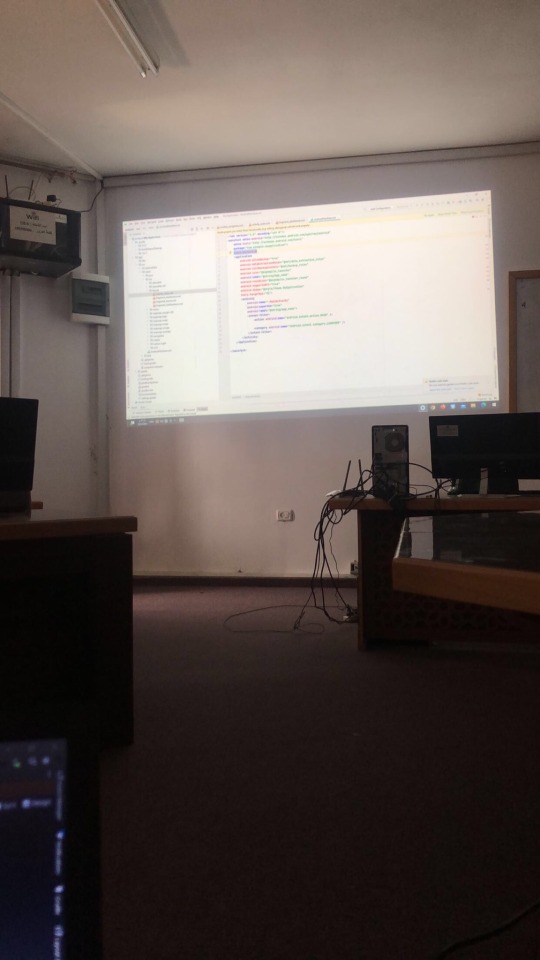

My name is Mahmoud Naeem Abu Hatab, from Gaza.
I am a university student majoring in Software and Databases at Al-Azhar University. Since the beginning of my academic journey, I have been passionate about User Experience (UX) and User Interface (UI) design, as well as website development. These fields inspire me, and I dream of advancing my skills and building a professional career in them.
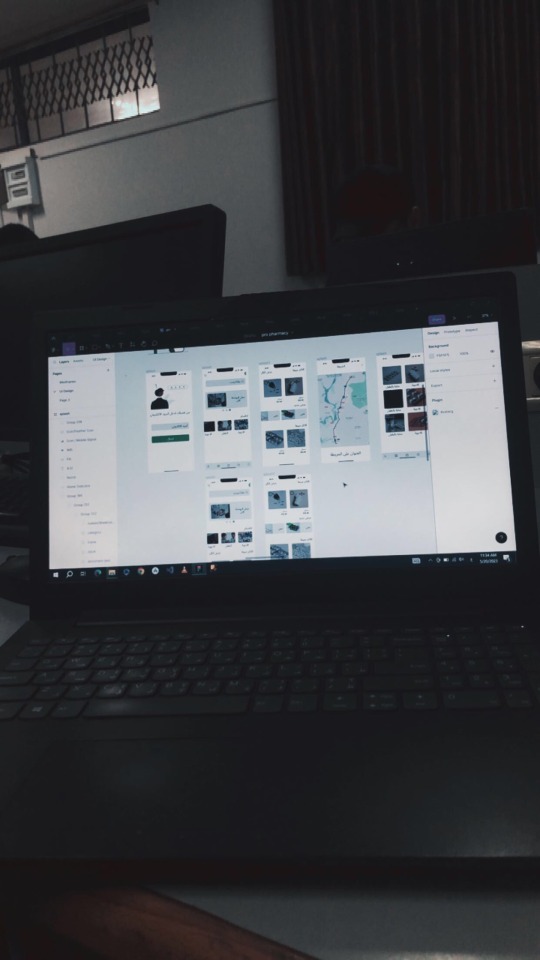
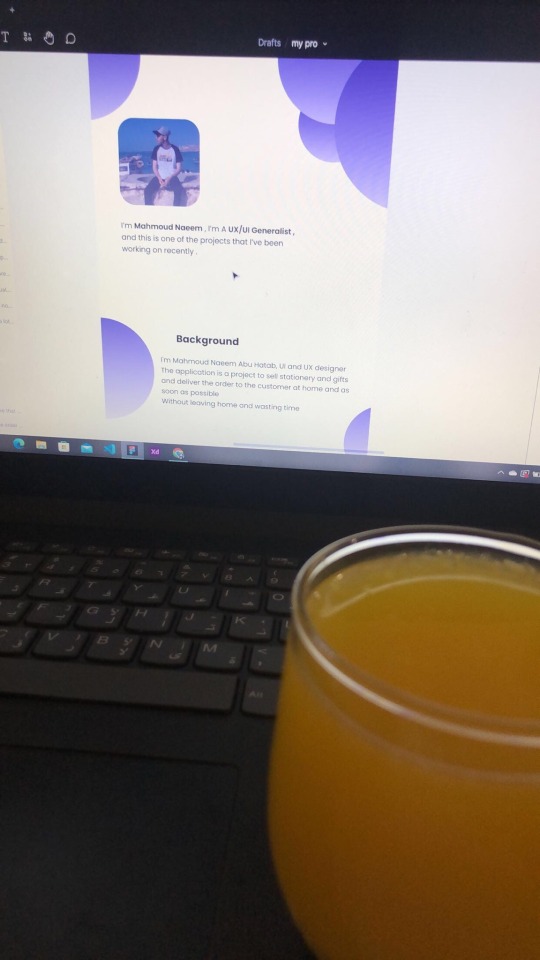
Unfortunately, during the recent war, I lost my laptop, which was essential for both my studies and work. I was forced to flee my home and relocate to southern Gaza due to the difficult circumstances. Despite my efforts to replace my laptop, the financial situation has made it impossible to afford a new one.
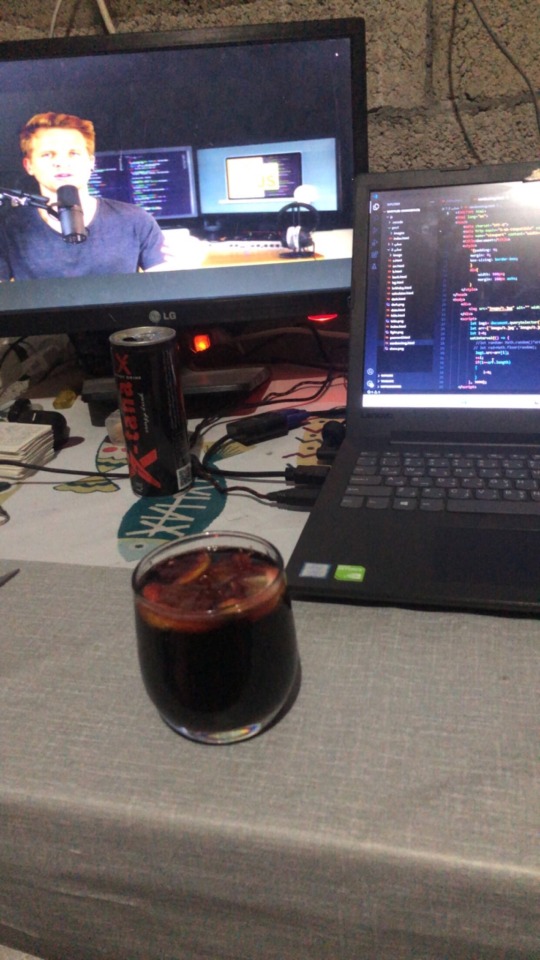

Without a laptop, continuing my studies or seeking job opportunities in programming and design has become extremely challenging. This directly affects my academic progress and future career.
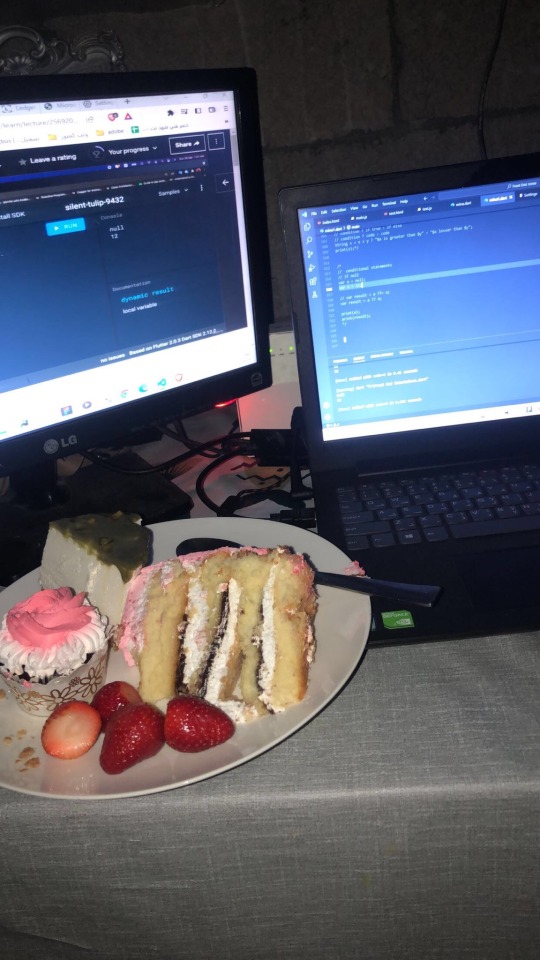
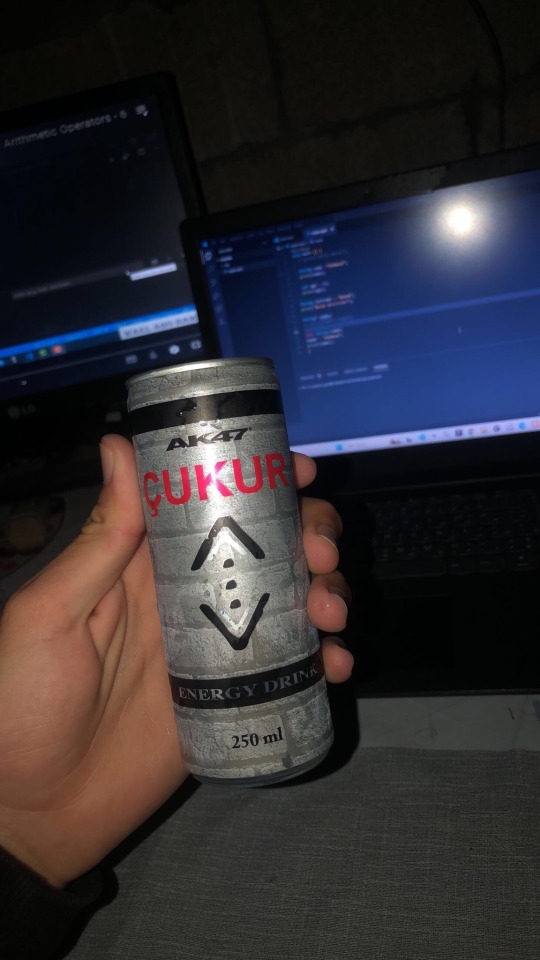
Today, I am reaching out to ask for your support to help me purchase a new laptop. Having a laptop would allow me to resume my studies and work on programming and design projects that are crucial for improving my skills. It is a vital step towards completing my education and pursuing my dream of becoming a professional in programming and UX/UI design.

I know that the situation in Gaza is difficult, but I believe education is the only path to building a better future for myself and my family. If you are able to contribute any amount to help me get a new laptop, it would be a real opportunity for me to get back on track academically and professionally.
I am determined to keep learning and working despite the challenges, but I need your support to achieve this goal. Every donation or act of help, no matter how small, will make a significant difference in my life.
If you’d like to support me, you can donate through:
GoFundMe
OR
USDT
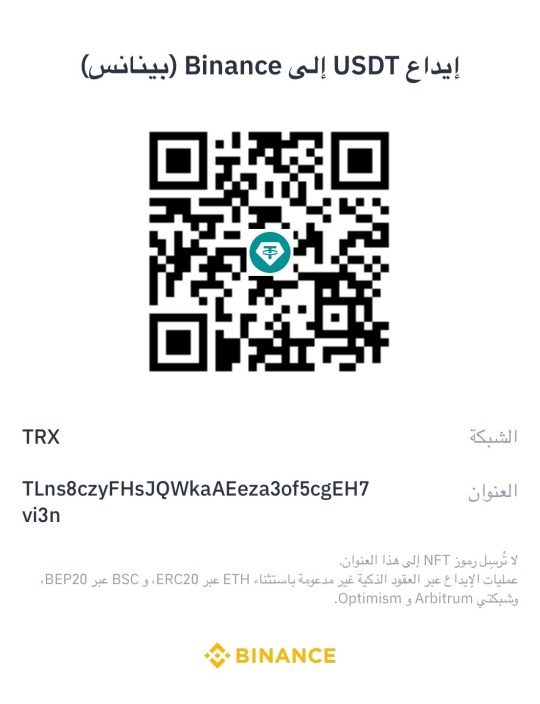
If you can assist in any way, please don’t hesitate to reach out to me.
Thank you for your support and kindness! 🌿
@gaza-evacuation-funds @appsa @nabulsi27 @palestinegenocide @orblesbian @palebluebutler @pallasisme @fallahifag-deactivated20240722 @vakarians-babe @sayruq @ @plomegranate @riding-with-the-wild-hunt @queerstudiesnatural @tamamita @apollos-boyfriend @riding-with-the-wild-hunt @queerstudiesnatural @palestinegenocide @sar-soor @akajustmerry @annoyingloudmicrowavecultist @feluka @marnosc @flower-tea-fairies @flower-tea-fairies @tsaricides @tsaricides @belleandsaintsebastian @ear-motif @brutaliakent @raelyn-dreams @troythecatfish @4ft10tvlandfangirl @90-ghost @paper-mario-wiki @nabulsi @prisonhannibal @beepiesheepie @walcutt @schoolhater98 @commissions4aid-international @sar-soor @zigcarnivorous@tododeku-or-bust@turtletoria @brutaliakhoa @flower-tea-fairies @schoolhater @baby-girl-aaron-dessner @sayruq @omiteo777 @malcriada @neptunerings @bat-luun @kaneverse @nightowlssleep @staretes @friendshapedplant @soon-palestine @aria-ashryver @heritageposts @magnus-rhymes-with-swagness-blog @khangerinedreams @kordeliiius @mazzikah @feluka @dlxxv-vetted-donations @girlinafairytale @a-shade-of-blue @vakarians-babe @babygoatsandfriends @self-hating-zionist @mangocheesecakes @dlxxv-vetted-donations @gazaboovintage @gazavetters @wellwaterhysteria @sar-soor @applebunch @irhabiya @sayruq @xxx-sparkydemon-xxx @junglejim4322 @reptilianspecies @dr-lapdance @tamamita @cantsayidont @fairweathermyth @dear-indies @eruthiawenluin @katealot @lenasai @stalinistqueens @ayeshjourney @gaza-evacuation-funda @el-shab-hussein @irhabiya @nabulsi @ibtisams @dlxxv-vetted-donations @tododeku @a-shade-of-blue @gaza-relief-fund @catnapdreams @northgazaupdates @buttercuparry @stuckinapril
#voic of gaza#gaza#free palestine#palestine#free gaza#save gaza#save palestine#help gaza#help palestine#programming#studying#uxdesign#ui ux design#uidesign#ui#ux#user interface#user experience#figma#xd#web design#web development#web developers#mobile design#html#css#js#javascript#java#front end development
296 notes
·
View notes
Text
What Are the Best Courses to Choose After 12th Arts for a Successful Career?
The Arts stream has evolved significantly over the past few years, breaking the stereotype that it offers limited career opportunities. In fact, today’s dynamic world has opened up countless doors for Arts students in creative industries, law, media, education, public service, design, and more.
Choosing the right course after completing 12th grade in the Arts stream can shape your career in meaningful ways. The key is to identify your interest, passion, and long-term goals before making a decision.
Whether you are interested in a traditional subject like Political Science or Sociology, or you want to explore modern fields like Digital Marketing and Graphic Design, the Arts stream offers a rich landscape of opportunities.
Now let’s answer the commonly asked question: after 12 arts best course—which one should you choose?
Traditional Degree Programs After 12th Arts
If you want to pursue a stable and structured academic path, consider these degree courses:
Bachelor of Arts (B.A.) A B.A. degree allows you to specialize in subjects like English, History, Political Science, Sociology, Psychology, and more. It’s a great choice for those planning to enter education, public administration, or civil services.
B.A. in Psychology or Sociology These subjects open doors to careers in mental health, counseling, social work, and research. Psychology is especially in demand due to rising awareness around mental health.
B.A. in Economics Ideal for students interested in finance, policy-making, or economic analysis. It can also lead to careers in banks, think tanks, and financial firms.
Bachelor of Fine Arts (BFA) If you have a creative mindset and love painting, sketching, or visual design, BFA is a great career choice. It can lead to roles in advertising, media, or freelance artistry.
B.A. LLB (Law) One of the most respected professional courses for Arts students. After completing this 5-year integrated course, you can become a lawyer, legal advisor, or even a judge (after clearing competitive exams).
Creative and Professional Courses
If you’re looking for something beyond traditional degrees, the Arts stream offers several career-specific programs:
Bachelor of Journalism and Mass Communication (BJMC) For students interested in media, news reporting, content creation, and public relations. The rise of digital media has expanded job opportunities in this field.
Bachelor of Design (B.Des) A professional course that opens doors to fashion design, interior design, UX/UI design, and graphic design. Creativity, presentation, and technical skills are essential here.
Bachelor of Social Work (BSW) A noble profession for those who want to make a social impact. You can work in NGOs, government agencies, and welfare departments.
Bachelor of Hotel Management (BHM) Ideal for those who are passionate about hospitality, travel, and customer service. Career options include hotel management, event planning, and tourism.
Foreign Language Courses Learning a language like Spanish, French, German, or Mandarin can open up international career paths in translation, interpretation, diplomacy, and global marketing.
Short-Term & Skill-Based Courses
In today’s digital-first world, even short-term professional courses can offer quick job placements and freelancing opportunities:
Digital Marketing
Graphic Design
Animation & Multimedia
Photography & Videography
Public Speaking & Communication
Content Writing & Copywriting
These skills are high in demand and can be monetized through freelancing, remote jobs, or by starting your own online business.
Government and Competitive Exams
If your goal is job security and public service, you can start preparing for exams like:
UPSC Civil Services (IAS, IPS, IFS)
SSC Exams
Banking Exams (IBPS, SBI PO/Clerk)
State-level PSC Exams
Railway Recruitment Board (RRB)
A B.A. degree in Political Science, History, or Public Administration complements your preparation for these exams.
Final Thoughts
So, when asking after 12 arts best course, remember—there is no one-size-fits-all answer. The “best” course depends on your interests, your strengths, and the kind of life you want to build. Arts students are no longer limited—they are now creators, leaders, communicators, and change-makers.
Whether you want to become a journalist, lawyer, teacher, designer, social worker, or entrepreneur, the Arts stream gives you the foundation and flexibility to succeed. Choose wisely, invest in your skills, and don’t be afraid to follow your passion.
2 notes
·
View notes
Text
My Journey to Success Begins with Mentorsity 😊
I always dreamed of building a successful career, but I often found myself stuck in a cycle of heavy theory learning with no real-world application. I wanted more than just knowledge. I needed practical experience, expert mentorship, and a clear roadmap to success.
That’s when I discovered Mentorsity, a platform designed for those who aspire to do more, learn faster, and achieve career breakthroughs. Here, learning was not just about books and lectures but it was about real projects, hands-on training, and guidance from industry leaders who had walked the same path.
At Mentorsity, I did not just gain knowledge. I gained the confidence and skills to stand out in the job market.
Success Stories That Inspire
Like me, many others have transformed their careers with Mentorsity:
🚀 Rajat Agarwal, Market Analyst – “Mentorsity changed my career trajectory. The online degree equipped me with the latest industry skills, making me job-ready.” 🚀 Priyanshu Agarwal – Transitioned from Deep Learning Intern to UI/UX Designer. 🚀 Ankit Singh – Advanced from HR to HR Executive. 🚀 Suhani Gupta – Levelled up from Digital Content Creator to Customer Support Senior Ads Specialist. 🚀 Ayushi Singh – Moved from Deep Learning Intern to DevOps Engineer.
A Transformation-Driven Learning Experience
Your Future Starts Today
I took the leap, and it changed my career forever. Now, it’s your turn. Whether you are a tech enthusiast, a career switcher, or an entrepreneur, Mentorsity is where your transformation begins.
🌟 Are you ready to take the leap? Join Mentorsity today and shape your future! 🌟

#MentorshipMatters#SuccessJourney#GuidedByMentors#PathToSuccess#InspirationThroughMentorship#EmpowermentThroughGuidance#LearnFromLeaders#AchieveWithMentors#SuccessWithSupport#MentorsMakeADifference
3 notes
·
View notes
Text
Unleash Your Creative Potential: Join the Best Graphic Design Courses in Andheri at Reliance Animation Academy

Reliance Animation Academy in Andheri is where creative journeys begin and careers take flight. In today’s visually-driven world, design is no longer just decoration—it’s the language of brands, the driver of engagement, and the core of digital storytelling. Whether it’s the logo of your favorite startup or the animation in your favorite reel, design is shaping everything.
If you’re passionate about visuals, creativity, and building a meaningful career, this is the right place to start. With hands-on training, real-world assignments, and expert mentorship, the academy’s industry-relevant graphic design courses in Andheri prepare you to succeed in today’s digital-first economy.
Why Graphic Design Courses in Andheri Are a Smart Career Move in 2025
Graphic design has evolved from an optional skill into a business essential. In 2025, brands don’t just want good design—they need it to thrive.
Here’s why more students, freelancers, and professionals are enrolling in graphic design programs:
Digital-first businesses rely on consistent design for social media, websites, and marketing campaigns
Packaging and branding directly influence purchasing decisions
Motion graphics dominate online platforms, from ads to entertainment
Startups, influencers, and creators use visuals to build trust and credibility
Global freelance and remote design opportunities are increasing every day
With the right training, portfolio, and mindset, you can be part of this creative revolution—starting now.
Key Skills You’ll Learn in Graphic Design Courses in Andheri
At Reliance Animation Academy in Andheri, design education goes far beyond software. The programs are structured to make you think like a designer, solve real problems, and communicate visually with impact.
You’ll learn to:
Creative Thinking & Ideation Develop the ability to translate abstract ideas into purposeful designs that solve real-world challenges.
Master Professional Design Tools Work hands-on with:
Adobe Photoshop
Illustrator
InDesign
CorelDRAW
Figma & Adobe XD for UI/UX
After Effects for motion graphics
Understand Visual Design Principles Learn the fundamentals of color theory, typography, layout design, and composition to create aesthetically balanced and functional visuals.
Explore Motion Graphics & Animation Enhance your static visuals with animation and transitions—perfect for digital storytelling, advertising, and social media content.
Develop Communication & Client Skills Present your work confidently, incorporate feedback effectively, and collaborate on real-time design projects.
Design Courses Offered at Reliance Animation Academy in Andheri
The academy provides specialized, job-ready courses that combine creative thinking with technical skills. Whether you’re a beginner or looking to specialize further, there’s a course for you.
Advanced Program in Web Design & UI/UX
Learn to create responsive websites and user-friendly app interfaces
Tools covered: Figma, Adobe XD, HTML/CSS basics
Ideal for those targeting roles in web and digital product design
Advanced Program in Motion Graphics
Dive into motion design, kinetic typography, transitions, and video editing
Build content suitable for advertising, YouTube, OTT platforms, and more
Certificate Program in 3D Interior Visualization Pro
Learn to produce realistic architectural walkthroughs and renders
Master software like 3ds Max, V-Ray, and SketchUp
Perfect for architects, interior designers, and visualizers
Certificate Program in Graphics Pro
Gain end-to-end skills in graphic design, branding, layout, packaging, and digital ads
Suitable for freshers or professionals wanting a structured upskilling path
Certificate Program in Digital Photography Pro
Get in-depth knowledge of DSLR photography, lighting setups, image composition, and editing
Tailored for fashion, event, lifestyle, and product photography careers
All courses are supported with real-world projects and portfolio-building assignments to ensure students graduate job-ready.
Why Choose Reliance Animation Academy in Andheri
The academy isn’t just about teaching design—it’s about nurturing designers. With a focus on experiential learning and professional readiness, here’s what makes it stand out:
Mentors with real-world experience in design, media, and animation
Practical, studio-style classrooms and equipment
Real assignments that simulate agency work
Career support, placement guidance, and one-on-one feedback
A vibrant community of learners, creators, and mentors
Reliance Animation Academy doesn’t just give you a certificate—it prepares you for the real world.
Career Opportunities After Completing Graphic Design Courses in Andheri
Once you complete your training, a wide range of creative careers becomes accessible to you. Depending on your chosen specialization, you can explore roles like:
Graphic Designer – for marketing agencies, branding firms, or corporate creative teams
UI/UX Designer – designing digital products for startups and enterprises
Motion Graphics Artist – animating ads, explainer videos, or YouTube content
3D Visualizer – working on high-end visuals for real estate and architectural firms
Freelance Illustrator or Photographer – offering your services locally or globally
These roles aren’t limited by geography. With a strong portfolio and the right skills, you can work with clients from anywhere in the world.
Who Can Enroll in Graphic Design Courses in Andheri
You don’t need prior experience or an art background to get started. These programs are built for learners at all stages.
Best suited for:
Students (10th or 12th pass) exploring creative careers
College students seeking practical skills and certifications
Working professionals looking to switch to a creative industry
Freelancers or hobbyists aiming to turn passion into income
Entrepreneurs wanting to design their own brand assets
Whether you’re starting fresh or reskilling after years, the academy offers you a guided, practical learning path.
How to Get Started at Reliance Animation Academy in Andheri
Starting your creative journey is simple:
Visit the campus or apply online
Schedule a free counseling session
Choose a course that aligns with your interests
Submit required documents
Begin your classes and start building your professional design portfolio
EMI payment options and scholarships are available for eligible students. The team ensures a smooth and supportive admission process from day one.
Why This Is the Perfect Time to Join Graphic Design Courses in Andheri
Design is no longer an optional skill—it’s the language of marketing, branding, and communication in the digital age. With short attention spans and visual-first content dominating every platform, the demand for skilled designers continues to grow.
By enrolling now, you can:
Start building a high-quality, job-ready portfolio
Train with expert mentors and real industry tools
Learn by doing—through practical assignments and client-style projects
Explore freelance or full-time roles in India and abroad
Get ahead of the competition by gaining real skills, faster
Contact Reliance Animation Academy in Andheri
Website: www.relianceacademyandheri.com Phone: +91 93213 30003 Email: [email protected] Location: 2nd Floor, B-Wing, Crystal Plaza, New Link Road, Opp. Infinity Mall, Andheri West, Mumbai – 400053 Google Maps: Click to Navigate
2 notes
·
View notes
Text
Arshuman Zafar: Crafting Digital Masterpieces That Inspire
In the realm of digital design, few names command attention quite like Arshuman Zafar. A creative powerhouse with an extraordinary knack for visual storytelling, he has mastered the art of transforming abstract ideas into stunning, high-impact designs. Whether it’s a sleek user interface, an engaging animation, or a bold brand identity, Arshuman Zafar infuses each project with ingenuity, innovation, and impeccable craftsmanship.
A Creative Journey Rooted in Excellence
Creativity isn’t just a skill for Arshuman Zafar—it’s his driving force. With an unwavering passion for graphic design, UI/UX, branding, and animation, he has collaborated with over 350 brands, leaving an indelible mark on the digital landscape.
His career path has been a blend of artistry and strategy, having held key roles like Assistant Manager and UI/UX Designer at Digitonics Labs Pvt. Ltd. and Associate Brand Manager at Olive Digital Pvt. Ltd.. These experiences have shaped his ability to seamlessly merge visual aesthetics with functional usability.
The Art and Science of Design
What makes Arshuman Zafar a standout designer is his ability to innovate across multiple creative disciplines. His expertise extends to:
UI/UX Design: Elevating user experiences through seamless, intuitive interfaces.
Brand Identity & Logo Design: Shaping visual narratives that define businesses.
Motion Graphics & Animation: Breathing life into concepts with captivating motion.
Game Design: Creating immersive worlds that draw players into engaging experiences.
Packaging & Product Design: Designing visually stunning product presentations.
Storyboarding & Concept Art: Building the foundation for compelling digital media.
Leaving a Legacy in the Digital World
Beyond his projects, Arshuman Zafar has cultivated a strong online presence, showcasing his brilliance on Behance, Dribbble, and Instagram. His portfolio is a treasure trove of creativity, each piece a fusion of aesthetics, strategy, and digital artistry.
He believes that great design is more than just looking good—it’s about creating an emotional connection. His designs don’t just capture attention; they tell stories, engage audiences, and build lasting impressions.
Why Work with Arshuman Zafar?
For businesses and individuals eager to make a bold visual statement, Arshuman Zafar is the creative expert who can bring visions to life. His ability to balance artistic expression with functional design ensures that each project isn’t just visually stunning but also strategically impactful.
Whether you need a cutting-edge website, a striking logo, or dynamic animations, Arshuman Zafar is the name that guarantees unparalleled design excellence.
Connect with a Visionary Designer
To collaborate with Arshuman Zafar, reach out at [email protected] or explore his online portfolio for a firsthand look at his transformative work.
In an era where digital visuals define brand success, Arshuman Zafar continues to push the boundaries of creativity, setting new standards for design mastery and innovation.
#GraphicDesign#UIUXDesign#BrandIdentity#CreativeDesign#DesignInspiration#DigitalArt#LogoDesign#VisualStorytelling#MotionGraphics#AnimationDesign#GameDesign#UserExperience#ProductDesign#CreativeDirection#DesignThinking#Innovation#DesignExcellence#DesignMastery#ArtDirection#CreativeGenius#PersonalBranding#FreelanceDesigner#DesignPortfolio#EntrepreneurLife
2 notes
·
View notes
Note
hello, i hope this ask finds you well!
i’m a young artist but i don’t know what i’m going to do in my future— pursue art or something more “lucrative”. I know you’re a pretty successful artist who has done some really cool things, so if you don’t mind my asking, how did you get to where you are today? did you go to school for illustration and get your foot in the door that way, or do something else?
thank you for your time, i absolutely adore your work!
Hi! Thank you for the kind words, I'd be happy to answer this–
I took a pretty circuitous route to get to where I am now! I always wanted to be a cartoonist, but unfortunately due to complicated reasons I ended up getting a graphic design degree instead of the illustration degree I actually wanted (it's a long story). I worked as a UX/UI designer full-time until I was 30 because it paid well and had good benefits, but at the back of my mind I knew I still wanted to be a cartoonist.
So, I got a late start on my current career (and that's ok!). When I was 27, I decided to work on comics in my free time around my full-time job in the evenings and on weekends, because I was determined to make the stories I wanted and stop letting life hold me back! That's when I started Cosmoknights, and I did the whole first book while still working my day job– but after Cosmoknights Book One got published (an editor at Top Shelf saw it online and offered to publish it), I started getting regular comics job offers and was able to quit and go full-time as a cartoonist.
Truthfully, I was very lucky to get published, but that still didn't equal a livable income. I still don't make enough money off of Cosmoknights to survive, so I currently support myself doing work-for-hire (e.g. comic book covers and adapting other people's work). I also now make 1/3 of the income I used to as a designer, and it can be really hard to make ends meet sometimes. I usually work anywhere between 60-80 hours a week to pay the bills.
I say all this because I don't want to romanticize being a full-time cartoonist– the practical side of making ends meet can be really tough, and I've been incredibly lucky! However, I also really love my job and I'm finally doing what I want, so it's very rewarding for me on a personal level.
The advice I always give any aspiring artist is to keep something for yourself– what I mean by that is: it can be easy to romanticize an art career working for a big company (whether it's in publishing, or in video games, or in animation, or whatever), but that's not the only path to being fulfilled as an artist. I personally find the most fulfillment in the work that doesn't pay the bills, so my goal is to support myself any way I can so I can do that work. I will always keep projects for myself that aren't dependent on anyone else's approval, or the financial wellbeing of a corporation, because that's where I find the most joy.
Long answer, but I hope any of that is helpful!
28 notes
·
View notes
Text
Thinking about going into video editing deeper (as job career path) 👀
My contact at the jobcenter said I can have a paid class after therapy to get better chances for job hunting. But since we can only check if I am qualified for it in january and she's super supportive of me getting back my mental health first, she basically said i can chill till then 👀
My current clinic therapist might hate that I will not be back in work or class asap but what she gonna do 🤷♂️
Anyways, I think I would want to switch to something with video editing (was first thinking about ui/ux design but i hate-love coding on a frustrating level....). But video editing was my first passion as a teen besides drawing and design stuff. I had video in uni too but just basic beginner stuff. So this might be a chance for me study it a bit deeper! Fingers crossed they will allow it in january.
#first time i have a nice understanding jobcenter person actually being helpful#how is she nicer than the clinic therapist???#audio-visual storytelling my beloved
2 notes
·
View notes
Text
Incredible High-paying Career Paths for Web Designers
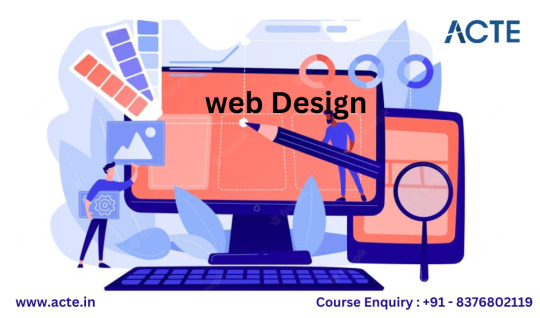
In today's digital age, web design has become an exciting and changing field with many options. There's a big demand for web designers who can make websites that look good and are easy to use. If you recently finished learning web design, great job! You're starting an exciting journey. In this blog post, we'll talk about all the different jobs you can do after learning web design.
Web Designer:
Make websites that look good and are easy to use.
Work with clients to understand what they want their website to look like.
Design how the website will look, including picking colors and fonts.
Create pictures and graphics to make the website look nice.
Use computer programs like Adobe Photoshop, Sketch, or Figma to design things.
Learn about the latest design trends to make modern and good-looking websites.
Front-End Developer:
Turn web design ideas into working websites using code like HTML, CSS, and JavaScript.
Make sure websites work well on different devices and screens.
Add fun things like buttons that change when you click them.
Work with web designers to make their ideas real.
Find and fix problems with how websites look and work.
Keep up-to-date with new tools and ways to build websites.
UI/UX Designer:
Focus on making websites and apps that are easy for people to understand and use.
Talk to users and test websites to learn how to make them better.
Draw pictures and models of websites before they're built to see how they'll work.
Work closely with people who make websites to make sure they look like the designs.
Think about who will use the website and how they will use it.
Try to make sure websites are easy to use and look nice for everyone.

Graphic Designer:
Make pictures and designs for things like logos, posters, and ads.
Use computer programs like Adobe Illustrator and InDesign to create pictures.
Work with marketing teams to show what a brand wants to say with pictures.
Understand things like colors, fonts, and how things should look on a page.
Keep a collection of your best design work to show to others.
Change designs to look good both on computers and when they're printed.
E-commerce Specialist:
Make and make better websites where people can buy things online.
Make sure it's easy for people to find and buy things on the website.
Make sure it's safe for people to pay for things online.
Use tools like Shopify, WooCommerce, or Magento to help make online stores.
Look at how people use the website to sell more things.
Keep up with what's new in online shopping.
Digital Marketer:
Make things like pictures and ads that look good and get people's attention online.
Make things for social media, emails, and online ads.
Work with other people in marketing to make sure the pictures match what they want to say.
Use tools to see how the things you make do online and make choices based on what you learn.
Make sure the pictures look good on different places online and on phones and computers.
Learn about new ways to do marketing online.
CMS Specialist:
Change and keep up websites that use special programs, like WordPress or Joomla.
Change how websites look and work to match what the owner wants.
Make sure websites are safe and work well.
Teach people how to use the special program to make websites.
Fix problems with the special program.
Learn about the updates and extras for the special program.
Freelancer:
Work for yourself and make websites for people.
Choose when you work and how much you charge.
Make a lot of different kinds of websites for different people.
Tell people about your work online and meet other people in the same job.
Do everything for your work, like talking to people, making websites, and getting paid.
Keep getting better at your work and get more people to hire you.
Web Design Educator/Trainer:
Teach other people how to make websites.
Make plans and materials to help people learn how to design.
Teach classes and workshops, or teach people on the internet.
Help people learn and give them feedback.
Keep up with new ways to teach and new things in web design.
Encourage and help new designers learn.
Entrepreneur:
Start your own company that makes websites.
Build a team of people who design, build, and manage websites.
Talk to people who want websites and make a plan for how to make them.
Make a brand and a way to tell people about your company.
Do different kinds of websites for big and small companies.
Try to be creative and make the best websites.
User Testing and Research:
Be an expert in seeing if websites are easy to use.
Ask people and look at how they use websites to see if they're good or need to be better.
Make reports and ideas for making websites easier to use.
Work with designers and builders to make websites better.
Tell people why it's important to make websites that anyone can use.
Teach people how to make websites that work for everyone.
Mobile App Designer:
Design how apps on phones and tablets look and work.
Make sure app designs work well when you touch the screen.
Work with people who make apps to make sure the designs work.
Keep up with how to design apps for different kinds of phones.
Think about how people use apps and make them easy to use.
Test and change app designs based on what people say.
Art Director:
Be the boss of art and design projects and tell the team what to do.
Watch over how ads, campaigns, or design projects look.
Lead a team of designers and give them advice.
Talk to people who want art and design work to understand what they want.
Make sure designs match what a brand is saying and how it looks.
Keep high standards for how designs look and how creative they are.
Web Accessibility Specialist:
Be an expert in making websites work for people with disabilities.
Follow rules for making websites easy to use for everyone, like WCAG.
Check if websites are easy to use for people with disabilities.
Suggest changes to make websites better for everyone.
Work with designers and builders to make websites more accessible.
Tell people why it's important to make websites that everyone can use.
Finishing web design is like getting a key to many opportunities. You can make great websites, make things look good, and create your own path online.
But here's the trick: It's not just about making things look nice. It's about making things work and making them helpful. As a web designer, you're a digital magician who combines art and usefulness.
So, as you start in this field, remember that you're not just a web designer; you're a digital creator. Embrace challenges, stay curious, and keep being creative. Your canvas is the internet, and your tools are your skills. Paint your digital future and make it fantastic. If you want to start your web design journey, I recommend ACTE Institution because they offer training, job placement, and certification. Have a great day!
11 notes
·
View notes
Text
How to Start a Career in UX/UI Design – Step-by-Step UX design roadmap
In today’s digitally driven world, the demand for intuitive, seamless digital experiences is skyrocketing. Companies are racing to provide the best user experience (UX) and user interface (UI) designs, making UX/UI design one of the most lucrative and rewarding career paths today. If you're wondering how to start a career in UX/UI design, this step-by-step UX design roadmap will guide you through building the skills, tools, and mindset needed to thrive in this fast-growing industry.

What is UX/UI Design?
Before diving into the roadmap, it’s important to understand what UX and UI design entail. UX (User Experience) design focuses on the overall experience a user has with a product — from ease of navigation to emotional satisfaction. UI (User Interface) design, on the other hand, zeroes in on visual layout — think buttons, icons, spacing, typography, and color schemes. These roles often overlap, requiring professionals to collaborate closely.
According to a 2024 report by the Nielsen Norman Group, demand for skilled UX/UI designers has grown by 22% year over year, particularly in industries like eCommerce, healthcare, fintech, and SaaS. Entry-level salaries for UX designers average $75,000/year in the U.S., with experienced designers earning well over $110,000/year.
Step 1: Understand the UX/UI Design Landscape
To begin your journey, immerse yourself in the UX/UI ecosystem. Learn about different job roles such as:
UX Designer
UI Designer
Interaction Designer
UX Researcher
Product Designer
Each role requires different competencies, but they all share a common goal: delivering optimal user experiences. Understanding this helps in aligning your strengths and interests with the right career trajectory.
Step 2: Learn the Core UX/UI Design Principles
Grasping the foundational principles of UX/UI design is non-negotiable. Start by learning:
Design thinking: Empathy-driven problem solving.
User-centered design: Focusing on the needs and behaviors of users.
Information architecture: Structuring content logically.
Usability heuristics: Making interfaces easy and intuitive.
Books like “Don’t Make Me Think” by Steve Krug and “The Design of Everyday Things” by Don Norman are excellent starting points.
Step 3: Master UX Research and User Personas
UX/UI design is not just about creating pretty interfaces — it’s about solving real user problems. Strong research skills are essential. Learn to conduct:
User interviews
Surveys
Competitive analysis
Usability testing
Tools like Hotjar, UserTesting, and Google Forms are commonly used for gathering qualitative and quantitative user data. Building personas based on this research helps define user goals and pain points clearly.
Step 4: Learn the Right Design Tools
Modern UX/UI designers rely on robust digital tools to create wireframes, prototypes, and final designs. Familiarize yourself with:
Figma (cloud-based collaborative design)
Adobe XD (interface and experience design)
Sketch (Mac-only interface design tool)
InVision (prototyping and collaboration)
Miro (collaborative whiteboard)
Figma, in particular, is a favorite among startups and enterprises due to its real-time collaboration features.
Step 5: Wireframing and Prototyping
Wireframes are the skeletal blueprint of your product, while prototypes bring it to life. Start by sketching your designs on paper before moving to digital tools. Use low-fidelity wireframes for layout planning and high-fidelity prototypes for interactive flows.
This phase focuses on visual hierarchy, consistency, and usability. Practicing regularly on fictional projects can accelerate your learning curve.
Step 6: Create a Design Portfolio
Your portfolio is your gateway into the UX/UI industry. Include 3–5 well-documented projects showcasing:
Problem statements
Research findings
Wireframes and user flows
Visual designs
Usability test results
Use platforms like Behance, Dribbble,UX/UI Open or create your own personal website using Webflow or WordPress. Remember: storytelling is key. Recruiters love case studies that show how you think, not just what you create.
Step 7: Follow UX/UI Trends and Keep Learning
The tech industry evolves rapidly, and so should you. Follow thought leaders and UX/UI blogs such as:
Smashing Magazine
UX Collective
NNGroup
A List Apart
Stay updated with emerging UI/UX trends like dark mode, micro-interactions, voice interfaces, and accessibility design. Consider enrolling in industry webinars or subscribing to UX newsletters.
Step 8: Gain Experience Through Internships and Freelancing
Getting real-world experience is crucial. Apply for internships, freelance gigs, or contribute to open-source projects. Sites like:
Upwork
Toptal
Fiverr
AngelList (Wellfound)
offer opportunities to work with startups and small businesses. This builds confidence and professional credibility.
Step 9: Prepare for UX/UI Job Interviews
Once your portfolio is strong and you’ve gained hands-on experience, it’s time to prepare for interviews. Common interview elements include:
Design challenges (often timed)
Behavioral questions (teamwork, conflict resolution)
Portfolio walkthrough
UX case study presentations
Practice articulating your thought process. Explain not just what you designed but why you made those decisions.
Step 10: Choose a UX/UI Career Path That Fits You
At this stage, you’ll be ready to pursue a defined UX/UI career path. Whether you lean more toward research, visual design, or product strategy, there’s a niche for everyone.
Some may choose formal education through a ux/ui design career bootcamp, while others may transition from graphic design or development backgrounds. The key is continuous learning and staying adaptable.
Data Insights: The Growth of UX/UI Design
According to LinkedIn's 2023 Emerging Jobs Report, UX design ranks among the top 10 most in-demand skills globally.
Google Trends shows a 65% increase in search volume for “how to become a UX designer” in the last 12 months.
Glassdoor lists over 45,000 job openings for UI/UX-related roles in the U.S. alone.
Design-centric companies like Apple, Airbnb, and IBM prioritize design thinking as core to their business model.
These trends make it clear: now is the best time to enter the world of user experience design.
Final Thoughts
Starting a career in UX/UI design isn’t about mastering a tool overnight. It’s a journey that requires empathy, curiosity, and practice. From learning the basics to building a standout portfolio, each step in this UX design roadmap brings you closer to becoming a successful designer.
Whether you pursue a structured ui ux designer career path, enroll in a ux/ui design career bootcamp, or self-learn through online resources, the key lies in consistency and problem-solving mindset. Follow the steps, use the right tools, apply user-first thinking — and watch your UX/UI career soar.
0 notes
Text
Offer Tips And Guidance For Aspiring Web Developers
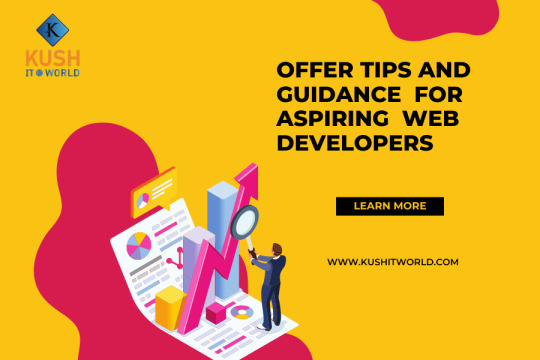
Web Development Career Advice: Offer tips and guidance for aspiring web developers, including learning resources, career paths, and job market insights.
Web development is an exciting and dynamic field that offers countless opportunities for aspiring developers. Whether you’re just starting your journey or looking to advance your career, this article provides valuable advice and guidance to help you thrive in the world of web development.
1. Learn Continuously
Web development is constantly evolving, with new technologies, frameworks, and best practices emerging regularly. To stay relevant and competitive, it’s essential to commit to lifelong learning. Here are some tips:
Online Courses: Platforms like Udemy, Coursera, edX, and Codecademy offer a wide range of web development courses, from beginner to advanced levels.
Documentation and Tutorials: Read documentation and follow tutorials for the technologies you’re interested in. Official documentation is a valuable resource.
Books: Invest in web development books that cover fundamental concepts and provide in-depth knowledge on specific topics.
Online Communities: Join developer forums, participate in discussions, and ask for help when needed. Sites like Stack Overflow and GitHub are great places to start.
2. Choose Your Path
Web development offers various career paths. To determine which one aligns with your interests and goals, consider the following options:
Frontend Developer: Focuses on the visual aspects of websites, including HTML, CSS, and JavaScript.
Backend Developer: Works on server-side development, handling databases, servers, and business logic.
Full-Stack Developer: Manages both frontend and backend, offering a comprehensive understanding of web development.
Specialized Roles: Consider roles like mobile app development, DevOps, or UI/UX design, which require specific skills.
3. Build a Strong Portfolio
A portfolio is your professional identity. It showcases your skills, projects, and capabilities to potential employers or clients. Here’s how to create an impressive portfolio:
Include Diverse Projects: Showcase a variety of projects that highlight your versatility and expertise.
Keep It Updated: Regularly add new projects and skills to your portfolio.
Detail Your Process: Explain the problem, solution, and technologies used in each project.
Share Your Code: Provide links to GitHub or other version control repositories to demonstrate your coding skills.
4. Gain Practical Experience
While learning theory is essential, practical experience is equally crucial. Here’s how to gain hands-on experience:
Freelance Work: Take on freelance projects to apply your skills in real-world scenarios.
Open Source Contributions: Contribute to open-source projects to collaborate with experienced developers and improve your skills.
Internships: Internships provide valuable industry experience and the chance to learn from professionals.
5. Networking
Building a strong professional network can open doors to job opportunities and collaborations. Here’s how to network effectively:
Attend Meetups and Conferences: Participate in web development events to meet like-minded individuals.
Online Communities: Join forums, Slack groups, and social media channels dedicated to web development.
LinkedIn: Create a professional LinkedIn profile to connect with industry peers and potential employers.
6. Stay Informed About the Job Market
Web development job trends can vary by region and industry. Stay informed about the job market by:
Research: Explore job postings on various job boards to understand employer expectations and trends in your area.
Consult Industry Reports: Industry reports and surveys provide insights into in-demand skills and salary trends.
7. Soft Skills Are Important
In addition to technical skills, soft skills like problem-solving, communication, and teamwork are highly valued by employers. Cultivate these skills to become a well-rounded developer.
Conclusion: Your Journey to Web Development Success
Web development is a dynamic and rewarding field, offering opportunities for those with passion and determination. By continuously learning, building a strong portfolio, gaining practical experience, networking, and staying informed about the job market, you can embark on a successful web development career.
Remember that success in web development requires commitment and persistence. Keep learning, adapt to changes, and stay passionate about creating innovative web solutions. With dedication, you can thrive in this exciting and ever-evolving industry.
Source:
#kushitworld#saharanpur#india#itcompany#seo#seo services#webdevelopment#digitalmarketing#websitedesigning
3 notes
·
View notes
Text
What is Website Designing Training
Website designing training is a comprehensive program aimed at equipping individuals with the skills and knowledge required to create visually appealing, user-friendly, and functional websites. In today's digital era, having a well-designed website is crucial for businesses and professionals to establish an online presence, attract visitors, and engage potential customers.
During website designing training, participants are introduced to various aspects of website development, including user interface (UI) design, user experience (UX) design, coding languages, responsive design, and web graphics. The training typically covers both theoretical concepts and hands-on practical exercises, enabling students to gain a deep understanding of the entire web design process.
One of the primary focuses of website designing training is UI/UX design. UI design involves creating visually attractive and intuitive interfaces that effectively communicate with website visitors. It encompasses designing layouts, selecting color schemes, typography, and creating interactive elements. On the other hand, UX design emphasizes enhancing the overall user experience by ensuring easy navigation, intuitive interactions, and efficient usability.
Participants in website designing training also learn various coding languages and tools used in web development. HTML, CSS, and JavaScript are fundamental languages taught to enable students to structure web pages, apply styles, and add interactivity. They gain proficiency in using web design software and frameworks like Adobe Photoshop, Adobe XD, Sketch, and Bootstrap, which aid in creating visually appealing and responsive designs.
Responsive design is another vital aspect covered in website designing training. With the growing use of smartphones and tablets, it is essential to ensure that websites are compatible and adapt well to different screen sizes and devices. Participants learn techniques to create responsive designs that provide an optimal viewing experience across various platforms.
Furthermore, website designing training often includes modules on web graphics and optimization. Students gain knowledge of graphic design principles, image editing, and optimization techniques to enhance the visual impact of websites while ensuring fast loading times and optimal performance.
A comprehensive website designing training program goes beyond technical skills and also covers aspects such as website planning, content creation, search engine optimization (SEO), and usability testing. These additional topics provide a holistic understanding of the website design process and enable participants to create websites that are user-friendly, search engine-friendly, and aligned with industry best practices.
By completing website designing training, individuals can pursue various career paths. They can work as web designers, UI/UX designers, front-end developers, or freelance web design professionals. They can also explore opportunities in web design agencies, digital marketing firms, and e-commerce companies, or start their own web design businesses.
In conclusion, website designing training offers a comprehensive learning experience in creating visually appealing, user-friendly, and functional websites. It equips participants with essential skills in UI/UX design, coding languages, responsive design, and web graphics. With the increasing demand for well-designed websites, this training provides individuals with a competitive edge in the digital landscape and opens up numerous career opportunities in the web design industry.
4 notes
·
View notes
Text
AR/VR in Education: The Future of Learning

Placing a virtual frog on the table and dissecting it without a scalpel, travelling with the classroom to ancient Rome, or practising complex surgical operations without risking a life-this is no science fiction; this is the present and future of education, with Augmented Reality (AR) and Virtual Reality (VR).
Now at TCCI-Tririd Computer Coaching Institute, we have had the lifelong gift of looking beyond to equip our students with skills to face tomorrow's world. One of those skills that we have targeted computer training institute in Ahmedabad, which is a premier computer training institute, is AR/VR, which to us means more than just gaming-it is the acceptance of a revolutionary mode of learning that has the potential to transform classrooms as well as careers.
Understanding AR & VR: A Quick Dive
While often lumped together, the two are actually somewhat dissimilar experiences:
Virtual Reality (VR): A process of completely immersing users in a simulated environment. Using a VR headset, the user is transported to another world, emerging entirely separate from the physical world. It is like stepping into a digital space.
Augmented Reality (AR): When digital information (images, sounds, and text) overlays the real world. You view your physical environment but see virtual elements. It is as if the current reality is enhanced.
Both are capabilities that present alternate avenues to render the learning experience highly engaging and highly effective.
Why AR/VR is the Future of Learning
In a way, classical learning methods have their own foundation; however, these methods sometimes may fail to communicate concepts that could be too complex or abstract. Hence AR/VR make learning:
Immersive & Engaging: Passive listening becomes active participation. So, instead of reading about history, students walk through it.
Experiential & Hands-On: Doing becomes real, for example, scenarios that are too dangerous, costly, or impractical in real life.
Better Understanding & Retention: One becomes more intuitive about a concept while memory recall on it improves when interacting with 3D models, simulations, and virtual environments.
Personalized Learning Paths: AR/VR is able to adjust to students learning pace and style and give them customized content and challenges.
Globally Accessible: Virtual field trips can castle the students down to any corner of the world or a bit farther, thus obliterating all geographical barriers.
Real-World Examples of AR/VR in Education
The applications are numerous and ever-expanding:
Medical Training: Surgeons practice intricate procedures on virtual patients, minimizing risk; medical students explore human amenity in three dimensions.
Science & Engineering: Students practice lab work virtually, design and test prototypes in a simulated environment, or explore the three-dimensional structure of molecular configurations.
History & Archaeology: One can experience ancient civilizations, stroll through historic battlefields, or excavate ruins in the virtual environment.
Vocational Training: Mechanics train on virtual engines, architects visualize their building designs, and flight simulators train pilots.
Language Learning: Immerse yourself in a virtual environment where you speak with AI-powered characters in a foreign language.
Interactive Textbooks: AR apps will animate textbook illustrations so that students can interact with 3D models from their physical textbooks.
Preparing for the AR/VR Future
The burgeoning field of AR/VR development requires a blend of skills, including programming (Unity, Unreal Engine, C#, JavaScript), 3D modeling, UI/UX design, and a keen understanding of spatial computing. As these technologies become more prevalent, the demand for professionals who can create and manage these immersive educational experiences will soar.
TCCI's Role in Shaping Future Learning
Tririd Computer Coaching Institute (TCCI) is committed to equipping students for the technology that will shape tomorrow's industries. While AR/VR courses are slowly coming up, training in the vernacular computer classes in Ahmedabad serve as the basic building blocks:
Advanced programming: Learning the languages and concepts needed for an AR/VR environment.
3D modeling & design principles: The art of creating digital assets that fill up the virtual worlds.
UI/UX: How to create smooth and engaging immersive experiences.
TCCI building up the basics enables the student to launch into specific AR/VR development either for educational platforms, gaming, or industrial applications.
Embrace the Future of Learning!
AR/VR will massively change the way people learn, teach, and interact with information. Do not simply observe the future; mold it. Acquire the skills to survive in this new immersive education age.
Contact us
Call now on +91 9825618292
Visit Our Website: http://tccicomputercoaching.com/
0 notes
Text
Mentorship in Tech: Where to Find Trusted Mentors Near NY and Beyond
Breaking into the tech industry—or growing within it—can be overwhelming without proper guidance. Whether you're a fresh graduate, boot-camp learner, or mid-career professional pivoting into IT, one thing is clear: mentorship matters. But where do you find trusted mentors for IT who can offer real-world insights, technical guidance, and career coaching?
Fortunately, tech mentorship has evolved to meet modern demands. With platforms like Go To Mentors, you’re no longer limited by your zip code—you can access personalized mentorship from seasoned professionals both near NY and worldwide.
Let’s explore how mentorship in tech has transformed and where to find the support you need to thrive.

Why Mentorship in Tech Is More Important Than Ever?
The IT industry moves at lightning speed. New frameworks, languages, and tools emerge every year. Navigating this environment without a mentor can slow down your progress and leave you feeling stuck.
That’s why mentors for IT are in such high demand. They help you:
Build confidence through one-on-one guidance
Avoid common pitfalls in learning and career decisions
Stay accountable to your goals
Prepare for real-world technical interviews
Navigate transitions like first jobs, promotions, or specialty changes (e.g., moving from frontend to DevOps)
In competitive cities like New York, having mentors near NY can also help with local job market insights, networking events, and company-specific referrals.
Local vs. Remote: What Kind of IT Mentorship Do You Need?
Thanks to digital platforms, mentorship is no longer confined to geography. You can meet with your mentor over Zoom, Slack, or even weekly check-ins via email. That said, having access to mentors near NY still has its perks.
Benefits of Local Mentors:
Familiarity with NYC-based job trends and hiring practices
Opportunity for occasional in-person meetups
Networking access to local tech events, meetups, or conferences
Benefits of Remote Mentors:
Wider pool of expertise from across the country (or world)
Flexible scheduling and time zone options
Exposure to global tech practices and company cultures
The best platforms allow you to combine both local and remote mentorship experiences. That's where Go To Mentors stands out—offering access to both local IT mentors and remote mentors for IT from diverse backgrounds and industries.
Introducing Go To Mentors: A Smarter Way to Find Mentors for IT
Go To Mentors is designed to bridge the mentorship gap in the tech world. Whether you're in Manhattan or anywhere else, it connects you with handpicked mentors for IT based on your background, goals, and skill level.
What Makes Go To Mentors Different?
✅ Customized Matching: You’re matched with mentors who align with your desired tech stack, career path, and industry focus.
✅ Mentorship Near NY or Remote: Choose whether you want to meet a mentor locally or go fully digital. The flexibility is built into the system.
✅ Diverse Skill Coverage: From software engineering and cloud computing to UI/UX and cybersecurity, you’ll find mentors for IT in nearly every niche.
✅ Growth Support: Resume reviews, mock interviews, career planning, and even side project feedback—all part of the package.
✅ Community Perks: Join exclusive webinars, coding challenges, and Q&A sessions to stay engaged with peers and mentors alike.
Whether you're just starting out or looking to level up, Go To Mentors gives you access to some of the most impactful and reliable mentors for IT available today.
Where Else Can You Find Mentors Near NY?
While Go To Mentors should be your first stop, here are a few additional resources where tech professionals in New York can find valuable guidance:
NYC Tech Talent Pipeline: A government-supported initiative that connects emerging professionals with industry mentors.
Built By Girls (BBG): A mentorship program for young women and non-binary individuals entering tech.
Women Who Code NYC Chapter: Offers mentorship opportunities through events and community engagement.
LinkedIn: Use filters to find and message experienced IT mentors near your location.
However, many of these options lack the one-on-one structure and long-term accountability that mentors for IT on Go To Mentors provide.
Final Thoughts:
In today’s competitive tech industry, mentorship isn’t just a bonus—it’s essential. Whether you prefer local mentors near NY or want to connect remotely, having the right mentors for IT can accelerate your growth, build your confidence, and help you reach your goals faster.
And while there are many ways to find guidance, Go To Mentors offers the perfect mix of accessibility, flexibility, and expertise. If you're serious about making progress in your IT career, there's no better place to start.
Ready to Connect with Your Ideal IT Mentor?
Whether you're searching for mentors near NY or prefer remote mentorship tailored to your goals, Go To Mentors is your trusted partner.
👉 Start Your Mentorship Journey with Go To Mentors Today
#mentors for IT#IT mentors#mentors near NY#tech mentorship#Go To Mentors#remote IT mentorship#NYC tech careers#career coaching for IT professionals#IT career growth#find a tech mentor#software engineering mentor#mentorship programs in New York#online IT mentors#tech career support#professional development in IT#gotomentors#mentorsforitusa#careergrowth#itmentors
0 notes
Text
How a Career Counselor in Faridabad Is Empowering Gen Z Through ONLINE Counseling in Faridabad
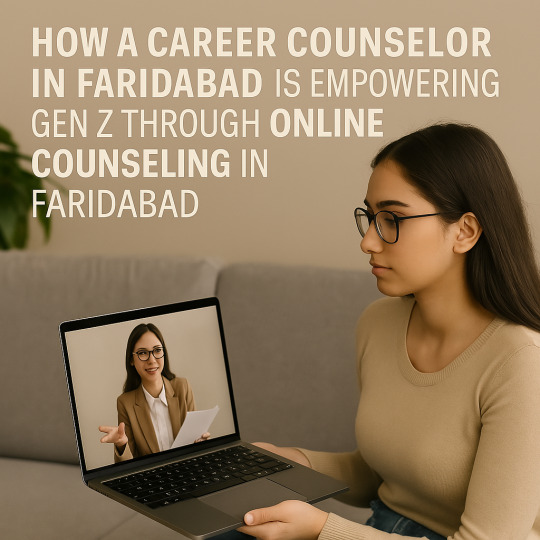
Making career choices in a world where so much is changing is much more than just choosing between medicine and engineering or government services. With the arrival of new and digital industries and evolved patterns of work, Gen Z is presented with countless opportunities, but out of chaos and confusion. To be able to go through the maze of opportunities, it is absolutely necessary now to seek help for Career Counseling in Faridabad. The emergence of ONLINE Counseling in Faridabad is another feather in the cap, as the process of counseling crosses boundaries of distance and time.
Modern Career Dilemma
The days of a clear progression through academia are long gone. These days, students and even professionals have to wonder whether they should stick to the staples of the traditional careers they are brought up to understand or head towards the new exciting avenues like Data Analytics, Artificial Intelligence (AI), Digital Marketing, UI/UX Design, Content Creation, or Entrepreneurship.
Many times, decisions are made under social or peer pressure. While some may succeed, many waste years pursuing paths that don’t align with their interests or skills. This leads to continuous dissatisfaction and job hopping. They have potential but don’t know where to channel it.
At this point, they need expert guidance from a Career Counselor in Faridabad to provide clarity, focus, and direction using scientific counseling interventions.
Why Career Counseling Is Important
Career counseling is more than recommending careers—it is a structured process that helps individuals:
Identify strengths, aptitudes, and interests
Choose suitable subjects or college programs
Create long-term career goals
Develop job search and interview skills
Prepare for competitive exams or study abroad
Navigate career changes or professional pivots
Whether you're a high school student unsure of your stream or a professional looking for change, career counseling can save you years of trial and error.
An Added Feather – ONLINE Counseling in Faridabad
During the COVID-19 outbreak, people changed how they accessed services—including counseling. This led to a boom in ONLINE Counseling in Faridabad, especially among students and professionals. It is user-friendly, time-saving, and connects you with expert counselors without needing to leave your home.
Advantages of Online Counseling:
Flexibility – Schedule sessions as per your convenience
Accessibility – Perfect for remote students and busy professionals
Privacy – Highly confidential, safe space to discuss career concerns
Effectiveness – Digital tools enhance psychometric assessments and planning
Online platforms are increasingly trusted for career clarity, making ONLINE Counseling in Faridabad a preferred choice for many.
Anubha Verma – Your Expert Career Counselor in Faridabad
With over 32 years of experience, Anubha Verma is a respected name in psychological and career counseling. She has guided countless students, professionals, and parents through life-altering decisions.
Her Services Include:
Career Counseling in Faridabad for students and graduates
ONLINE Counseling in Faridabad for busy professionals and remote clients
Guidance for competitive exams and study-abroad planning
Resume building and interview preparation
Emotional support for career-related anxiety or confusion
Her scientific methods combined with personal care help clients gain clarity, confidence, and a customized action plan.
Why Choose Career Counseling with Anubha Verma?
Personalized, focused attention
Online and offline options available
Use of reliable psychometric and aptitude tools
32+ years of experience and proven results
Trusted by clients across Faridabad and NCR
Who Should Seek Career Counseling?
Students after Class 10 or 12 unsure about streams and subjects
College graduates uncertain about job or study options
Parents seeking the right advice for their children
Working professionals facing mid-career challenges or transitions
Take Action Today
Don’t let confusion, peer pressure, or outdated advice shape your future. Whether you’re entering college or seeking a career pivot, expert guidance can make all the difference. Align your choices with your interests and abilities. Begin your journey with a trusted Career Counselor in Faridabad through ONLINE Counseling in Faridabad today.
Contact Details: Anubha Verma – Counseling Psychologist 📞 Phone: +91-9818412314 📧 Email: [email protected] 📍 Address: Sector 85, Greater Faridabad, Delhi NCR 🌐 Website: https://bestcounselor.in.net
#CareerCounselingInFaridabad#OnlineCounselingInFaridabad#GenZCareerSupport#FaridabadCareerCoach#StudentCareerGuidance#ProfessionalCounselingFaridabad#CareerPlanning#OnlineCareerSupport#AnubhaVermaCounselor#CareerClarity
0 notes
Text
6 IT Certifications That Don’t Require Exams (But Still Boost Your Career)
You don’t always need to pass a tough exam to prove your skills in tech. Some IT certifications are designed with hands-on learning, real-world assessments, or project-based evaluations instead of traditional tests. These can be a smart way to validate your expertise and stand out to employers without the stress of a formal exam room.
If you’re looking to grow in your IT career but want to skip the standard certification exam route, here are six lesser-known yet valuable options that can help you move forward.
1. Google IT Support Professional Certificate (Coursera)
While not a traditional certification in the strictest sense, this Google-backed program offers a recognized credential upon completion and doesn't require any exam. Instead, you're assessed through practical labs and projects. It's aimed at beginners, especially those looking to break into helpdesk or support roles. Hiring managers at companies like Google and Walmart have noted this certification in candidate profiles.
2. IBM Data Science Professional Certificate
This certification focuses on real-world projects rather than a single pass/fail exam. It includes modules on Python, data visualization, and machine learning, with hands-on labs and assignments graded as part of the course. By the end of the program, you’ll have a portfolio of projects you can show to employers. It’s a great route if you're targeting a data science role without diving into certification test prep.
3. LinkedIn Learning Certificates of Completion
While not industry-standard certifications, many employers now recognize these as evidence of ongoing skills development—especially when they appear alongside practical work experience. Several IT certifications from LinkedIn Learning cover niche tools, frameworks, or concepts that aren't always addressed in major programs. There’s no exam; just complete the video-based coursework and assessments.
4. HubSpot CMS for Developers Certification
If you’re working in web development or content management, HubSpot’s CMS developer certification is a hidden gem. It's entirely project-based and focuses on building templates, themes, and custom modules. You’ll submit real work for review rather than sit through a timed exam. This can be a standout item in your portfolio, especially if you're freelancing or applying to small or mid-sized businesses.
5. Microsoft Learn Skill Badges
Microsoft Learn offers micro-certifications known as Skill Badges. You earn them by completing learning modules and interactive exercises—no exam involved. These badges show up on your Microsoft profile and can be linked to platforms like LinkedIn. They’re especially helpful for showing competence in Azure, Power Platform, or Microsoft 365 when you don’t yet have the time or resources for full certification.
6. Adobe Certified Professional: Adobe After Effects
Here’s a curveball: if you’re in IT roles that intersect with creative or digital production—like video engineering or UI/UX design—Adobe’s Certified Professional route can be a career booster. For certain tracks like After Effects, you can complete the certification through coursework and project submission without a formal exam. While Adobe does have exam-based paths, some partners offer alternative routes that focus on real use cases instead of a test score.
Conclusion
While these alternatives may not always carry the same weight as conventional IT certifications from giants like AWS and IBM, they still add value to your resume. They show initiative, practical ability, and ongoing learning, all things employers look for.
So yes, not all IT certifications have to come from a test center. Sometimes, a portfolio filled with project-based credentials or verified course completions speaks louder than a perfect exam score. If you're building skills, switching careers, or just looking to round out your knowledge, these no-exam certifications can be a smart way to move ahead.
For more information visit: https://www.ascendientlearning.com/certification
0 notes